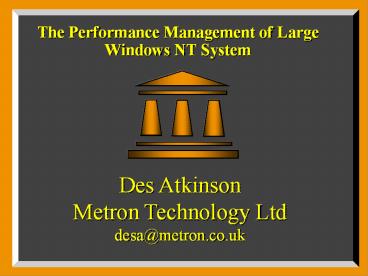The Performance Management of Large Windows NT System - PowerPoint PPT Presentation
1 / 20
Title:
The Performance Management of Large Windows NT System
Description:
Title: Presentation Subject: Metron & Athene/Unix Author: Laurence Halliwell Last modified by: Des Atkinson Created Date: 11/6/1996 9:43:32 PM Document presentation ... – PowerPoint PPT presentation
Number of Views:43
Avg rating:3.0/5.0
Title: The Performance Management of Large Windows NT System
1
The Performance Management of Large Windows NT
System
Des Atkinson Metron Technology Ltd desa_at_metron.co.
uk
2
Contents
- Introduction
- Scalability
- NT and mixed workloads
- Capacity planning of large NT systems
- Management issues
- Conclusions/questions
3
Scalability
- Clusters
- MSCS
- Other offerings
- Symmetric multi-processing
- Large memory systems
- Application scalability
- NT v5.0 enhancements
4
Clusters
- Microsoft Cluster Server
- Shared-nothing, failover model
- 2 non-identical nodes
- Includes application failover
- Scalability of MSCS lies in the future
- Other providers, e.g. Digital Enterprise Cluster
5
Symmetric Multi-Processing
- Standard product supported up to 4-CPU systems
- NT 4.0 Enterprise Edition took this up to 8 CPUs
- More scalable versions available from OEMs
- Asymmetry of NT SMP implementation
6
(No Transcript)
7
Large Memory Systems
- NT is a 32-bit OS
- Supports up to 4GB of virtual memory
- 2 GB for users
- 2 GB reserved for system
- Enterprise Edition increased user share to 3 GB
- NT 5.0 will offer 64-bit VLM
8
Application Scalability
- Exchange Server v5.5
- Removal of 16 GB limit on size of the Message
Store - Support for automatic failover in MSCS
- SQL Server v7.0 (Sphinx)
- Full dynamic locking
- Parallel threads
- VLM support
- Support for automatic failover in MSCS
9
NT v5.0 Enhancements
- Active Directory and DFS
- Support for I2O
- Event Trace Facility
- Discussed more fully later
- Microsoft Management Console
- Disk quotas, Kerberos, IPSEC etc.
10
NT and Mixed Workloads
- NT Server not a Mainframe OS
- No GOAL mode as in MVS
- No tools at the OS level to arbitrate between
workloads - Plenty of tweaks available at the application
level
11
Capacity Planning
- NT Performance Monitor
- Shortcomings in PerfMon itself
- Shortcomings in underlying metrics
- NT v5.0 Event Trace
- Capacity planning of clusters
12
NT Performance Monitor
- PerfMon is an application - users can write their
own - Metrics have shortcomings
- Log facility is nearest you get to an historic
performance database - No built-in planning capability
13
NT 5.0 Event Trace
- Comes with NT 5.0 Beta 2
- Programming tool to allow applications to be
instrumented - Will give lots of new metrics
- Overhead very low?
- To be part of WBEM
14
Following Slides based on talk given at US CMG 97
- Authors are Jee Fung Pang and Melur Raghuraman of
Microsoft
15
Data Requirements for CP
- Process/Thread Termination between sampling
intervals - Per Process I/O Counts
- Per Process/Thread per device I/O
- Transaction Boundaries
- File Based Collection
- Per Process/Thread Hard Page Fault Counts
16
NT 5.0 Instrumentation
- Events traced
- Process/Thread Create/Delete
- Physical Disk I/O and Page Fault
- Detailed Metrics can now be derived
- Detail metrics for process, threads and disks
- Allows per device metrics for every thread and
process - Bottleneck analysis tools
- e.g. hotfiles, hotdisk, topcpu with drilldown
17
Trace for Applications
- API available
- Allows event tracing to be built into the
application - Can provide data such as
- transaction response time, throughput
- transaction-level metrics of CPU and I/O
- Will Microsoft include these in their servers,
e.g. SQL Server?
18
Capacity Planning of Clustered Systems
- CP of clusters has already been provided on
OpenVMS and UNIX - Unit resource usage
- Tracking transactions
- Multi-tier client-server configurations
19
Running the Enterprise on Windows NT
- Account management issues
- Dealing with Microsoft
- Support issues
- What channels are available
- Technical manageability
- Internal support issues
- Compaq/Digital and others
- The new one-stop suppliers?
20
Conclusion
- Until now, Windows NT was not ready to run the
enterprise - NT v5.0 should represent a major advance in the
enterprise - Wise to wait until SP2 is out unless you feel
very brave (early 2001?) - How will the competition respond?































